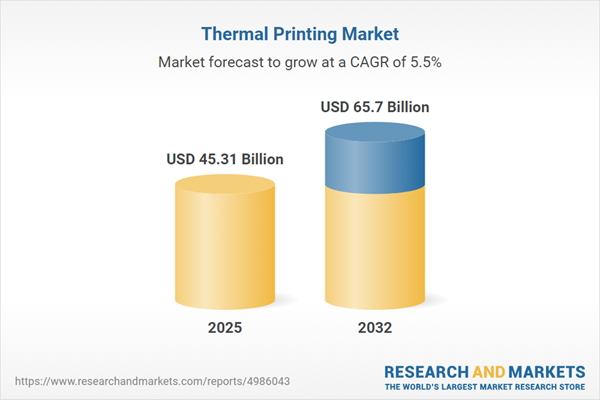Speak directly to the analyst to clarify any post sales queries you may have.
The global thermal printing market is advancing rapidly as enterprises across sectors transform operations through technology-enabled efficiency, durability, and adaptability. Industry evolution is guided by technological innovation, supply chain resilience, and the imperative to meet strategic business objectives in a connected, data-driven environment.
Market Snapshot
In 2024, the thermal printing market was valued at USD 42.96 billion and is set to increase to USD 45.31 billion in 2025. With a projected CAGR of 5.45%, industry value is expected to reach USD 65.70 billion by 2032, reflecting consistent demand across retail, logistics, healthcare, and manufacturing.
Scope & Segmentation
This research provides a comprehensive analysis of the thermal printing market across multiple dimensions:
- Printer Type: Desktop (compact, light duty), industrial (standard, wide format), and mobile (portable, rugged) devices.
- Technology: Direct thermal, and thermal transfer including resin, wax, and wax resin variants for diverse application needs.
- Connectivity: Ethernet, serial, USB, and wireless (Wi-Fi, Bluetooth) options support integration into both legacy and advanced digital environments.
- Print Resolution: Devices offering 203 DPI for basic labeling, 300 DPI for enhanced clarity, and 600 DPI for applications requiring fine detail.
- Application: Solutions tailored to healthcare, manufacturing, retail, and transportation logistics.
- End User: Government agencies, healthcare providers, logistics operators, manufacturers, and retailers.
- Regions: Detailed coverage includes the Americas (North and Latin America), Europe, the Middle East, Africa, and Asia-Pacific, addressing local market drivers and regulatory environments.
Key Takeaways
- Intelligent thermal printers are now equipped with sensors and support edge computing, facilitating real-time analytics and remote monitoring within interconnected supply chains.
- Material science advancements extend device longevity and enhance resistance to heat, chemicals, and abrasion, supporting critical labeling in demanding sectors.
- Growing adoption of cloud-native print management platforms streamlines device deployment and reduces support costs, directly aligning with broad digital transformation initiatives.
- Sustainability targets are accelerating the use of recyclable media and energy-efficient mechanisms, demonstrating that commercial objectives and environmental responsibility are achievable together.
- Collaborative business models and modular printer architectures have emerged in response to industry-specific challenges, ensuring operational continuity and future scalability.
Tariff Impact
Recent United States tariffs on thermal printing components have introduced new pressures into global supply chains, prompting shifts in sourcing strategies and encouraging component standardization. Industry participants have responded by diversifying supplier relationships and pursuing modular product designs. Multi-sourced procurement and volume-based agreements have helped stabilize pricing and sustain competitive positioning across essential sectors. Ongoing adaptability in procurement and open communication with trade authorities remain vital for effective risk management in the face of regulatory uncertainty.
Methodology & Data Sources
The report leverages structured executive interviews, industry expert insights, and a robust review of company documentation. Data integrity is maintained through quantitative triangulation and peer validation, utilizing both primary and secondary sources. Advanced visualization tools ensure clarity of segmentation and regional analysis.
Why This Report Matters
- Enables senior decision-makers to navigate complex supply environments and guide strategic investments in thermal printing infrastructure.
- Identifies innovation hotspots, compliance needs, and sustainability trends with direct relevance to sector-specific business growth.
- Informs procurement, operations, and technology integration planning with actionable, validated insights for global and regional markets.
Conclusion
The thermal printing market’s evolution reflects a balance of technological advancement, supply chain agility, and sustainability in response to regulatory changes. This research provides decision-makers with the perspectives and strategic direction necessary for confident adaptation and future market leadership.
Additional Product Information:
- Purchase of this report includes 1 year online access with quarterly updates.
- This report can be updated on request. Please contact our Customer Experience team using the Ask a Question widget on our website.
Table of Contents
3. Executive Summary
4. Market Overview
7. Cumulative Impact of Artificial Intelligence 2025
Companies Mentioned
The companies profiled in this Thermal Printing market report include:- Zebra Technologies Corporation
- Brother Industries, Ltd.
- Seiko Epson Corporation
- Honeywell International Inc.
- SATO Holdings Corporation
- Toshiba Tec Corporation
- TSC Auto ID Technology Co., Ltd.
- Citizen Systems Japan Co., Ltd.
- Star Micronics Co., Ltd.
- Dai Nippon Printing Co., Ltd.
Table Information
| Report Attribute | Details |
|---|---|
| No. of Pages | 187 |
| Published | October 2025 |
| Forecast Period | 2025 - 2032 |
| Estimated Market Value ( USD | $ 45.31 Billion |
| Forecasted Market Value ( USD | $ 65.7 Billion |
| Compound Annual Growth Rate | 5.4% |
| Regions Covered | Global |
| No. of Companies Mentioned | 11 |









